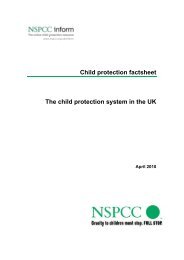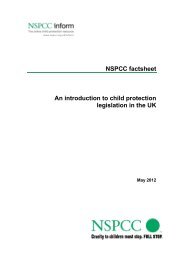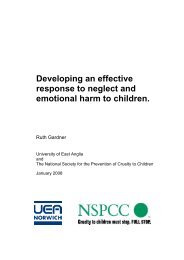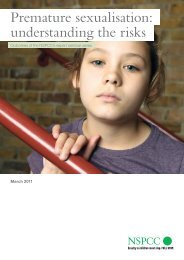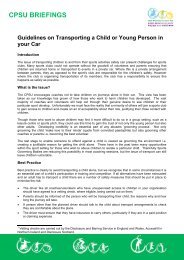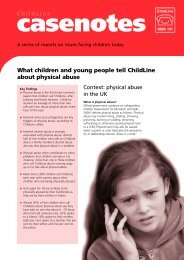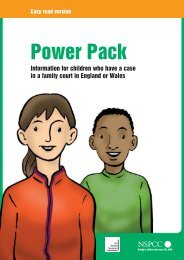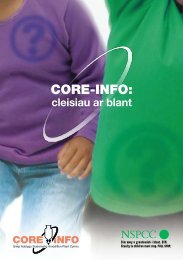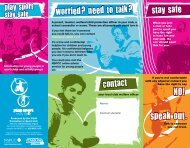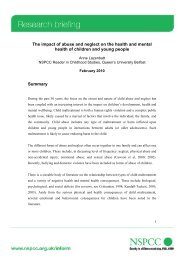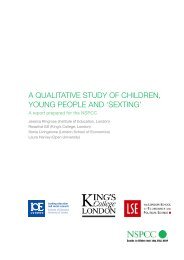Neglect and serious case reviews (PDF, 735KB) - nspcc
Neglect and serious case reviews (PDF, 735KB) - nspcc
Neglect and serious case reviews (PDF, 735KB) - nspcc
Create successful ePaper yourself
Turn your PDF publications into a flip-book with our unique Google optimized e-Paper software.
<strong>Neglect</strong> iN all ScrS from 2009–11<br />
To capture neglect beyond that formally recognised by a child protection plan, we used<br />
wider, but still stringent, criteria to search for neglect. There was neglect in a total of<br />
60 per cent (83) of the 139 available <strong>serious</strong> <strong>case</strong> <strong>reviews</strong> from the two year period<br />
2009–11. In most <strong>case</strong>s neglect had not been formally recognised but the experiences<br />
for the child <strong>and</strong> the consequences of neglect were as <strong>serious</strong> as when a CP plan was in<br />
place.<br />
As in the CP plan <strong>case</strong>s, neglect featured evenly across the age ranges apart from among<br />
11–15 year olds where it was much more common. Where children died, current or past<br />
neglect was evident for almost all whose deaths were related to but not directly caused<br />
by maltreatment (SUDI, suicide, accidents <strong>and</strong> ‘other’). There was neglect in a quarter<br />
of the deaths through assault <strong>and</strong> deliberate homicide.<br />
There was neglect in over two thirds of the 43 non-fatal <strong>case</strong>s (<strong>and</strong> in five of the seven<br />
<strong>serious</strong> sexual abuse <strong>case</strong>s). <strong>Neglect</strong> was evident for two thirds of the children who<br />
suffered non-fatal physical assault.<br />
a detailed Study of 46 caSeS of Severe <strong>Neglect</strong>, iN Six themeS<br />
malnutrition<br />
To underst<strong>and</strong> more about how neglect can be life threatening, we studied anonymised<br />
<strong>case</strong> summaries from 46 neglect related <strong>serious</strong> <strong>case</strong> <strong>reviews</strong> from the eight year period<br />
2003–2011. These included children with <strong>and</strong> without a CP plan for neglect. We found<br />
a six-fold typology of neglect related circumstances. Learning points arose in relation to<br />
each of the six individual themes <strong>and</strong> there were overriding, general points applicable to<br />
most:<br />
For this research malnutrition is defined as ‘life-threatening loss of weight or failure to<br />
gain weight or <strong>serious</strong> conse quences of neglecting to nourish the child’.<br />
Learning points:<br />
Executive Summary<br />
• None of the children who died or nearly died from malnutrition were in the child<br />
protection system. The family’s contact with any agency was almost non-existent by<br />
the time of the child’s death or <strong>serious</strong> harm.<br />
• Increased isolation of a family adds to the invisibility of the child or children so<br />
malnutrition is not recognised (for example when children are isolated because they<br />
cease to attend school or nursery or are home-schooled). Isolation of the child from<br />
the outside world means that very poor relationships between the child <strong>and</strong> caregiver<br />
(so poor that the child may have ceased to exist for the adult) cannot be observed by<br />
professionals or the public.<br />
11




